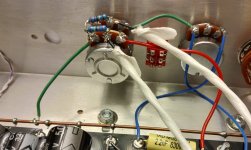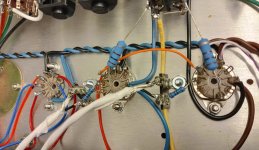Insulating wires after soldering - better than tape, like "split" heat shrink tubing
I'm looking for something that's kind of a cross between electrical tape and heat-shrink tubing. I've already made the connection, so I can't use heat-shrink without undoing the connection. I didn't put the heat-shrink on before soldering because it's two-conductor shielded wire, and I'm only using one conductor, so there's a fairly big discrepancy in diameter along the section I want to tape off. I could use electrical tape, but besides looking sloppy, I feel like the adhesive loses its tackiness over time.
Attached are a couple pictures of the work. On the end by the potentiometer, I'd just like to cover up that little bit of exposed shielding and other conductor. On the end by the tube sockets, I'd like to cover up the exposed shielding that is connected to the chassis.
A quick job for electrical tape, but I feel there's got to be a better solution. I'm thinking maybe something like heat-shrink tubing that is split lengthwise, and also has some decent adhesive. But I don't know if anything like that exists. I could also coat stuff in hot melt glue, but that's also messy and hard to guarantee I get complete coverage.
Thanks!
I'm looking for something that's kind of a cross between electrical tape and heat-shrink tubing. I've already made the connection, so I can't use heat-shrink without undoing the connection. I didn't put the heat-shrink on before soldering because it's two-conductor shielded wire, and I'm only using one conductor, so there's a fairly big discrepancy in diameter along the section I want to tape off. I could use electrical tape, but besides looking sloppy, I feel like the adhesive loses its tackiness over time.
Attached are a couple pictures of the work. On the end by the potentiometer, I'd just like to cover up that little bit of exposed shielding and other conductor. On the end by the tube sockets, I'd like to cover up the exposed shielding that is connected to the chassis.
A quick job for electrical tape, but I feel there's got to be a better solution. I'm thinking maybe something like heat-shrink tubing that is split lengthwise, and also has some decent adhesive. But I don't know if anything like that exists. I could also coat stuff in hot melt glue, but that's also messy and hard to guarantee I get complete coverage.
Thanks!
Attachments
Shrink Wrap Slit Tubing - Resource Center
They cut and glue it back with super glue.
I saw other options, but expensive
https://www.amazon.com/Shrink-N-Repair-Wrap-Around-Heat-Shrink/dp/B01DE199U8
They cut and glue it back with super glue.
I saw other options, but expensive
https://www.amazon.com/Shrink-N-Repair-Wrap-Around-Heat-Shrink/dp/B01DE199U8
Once you slit a tube, it becomes tape.
THIS product was expressly created to solve your problem:
Liquid Tape - PLASTI DIP(R)

THIS product was expressly created to solve your problem:
Liquid Tape - PLASTI DIP(R)

It's called self-amalgamating or self-fusing tape. Super useful stuff.
Wrap something, let it sit for an hour, and yer done.
Wrap something, let it sit for an hour, and yer done.
+1 for the self-amalgamating tape, provided you can wrap it tightly around whatever needs to be insulated or protected. You can even use it outside to protect joints against rain.
Self fusing/amalgamating tape is excellent, but the Liquid Tape I suggested is a paste, you apply it with a brush (I wouldn´t trust the spray can version very much, plus it must be a mess to clean overspray).
It most certainly MUST stand temperature, after curing.
Check the datasheet.
It most certainly MUST stand temperature, after curing.
Check the datasheet.
The self fusing is un-vulcanized rubber. Sold as 3M "splicing tape" The only tape suitable for electrical work. Certainly that traditional black electrical tape has no place near anything electrical as the glue turns to goo and the vinyl gets brittle.
But I do not know why you feel the need. We have built point to point chassis like your pictures for darn near 100 years without it. I think you are looking for a solution with no problem.
But I do not know why you feel the need. We have built point to point chassis like your pictures for darn near 100 years without it. I think you are looking for a solution with no problem.
I feel the same. Do you expect those wires to move around in there? Surely Fender did not build hundreds of thousands of amp chassis feeling the need to sleeve everything.
This is a combo guitar amp that I do expect to gig with (when the pandemic is over!), so between the vibrations from the speaker at volume and being moved around, yes I do expect some movement of the wires. That said, the pictures don't really show the depth, and there's plenty of space around the exposed conductors, so practically speaking, I agree, those wires should never move enough to be a problem.
But, let me ask the opposite question: is there any downside (other than time and cost) to putting a sleeve on those wires? And I do think the sleeves will make things look more tidy... though to be fair, I'll only see the wiring when it's being modded or serviced!
But I have another tube guitar amp I built, where the wiring is more dense than this one. And there are a few areas where I think there's a more compelling case for some kind of sleeve (currently using electrical tape). It was my first tube amp build, so not as neat as it could be; I need the sleeving to make up for sub-optimal wiring/soldering work in a few places.
But, let me ask the opposite question: is there any downside (other than time and cost) to putting a sleeve on those wires? And I do think the sleeves will make things look more tidy... though to be fair, I'll only see the wiring when it's being modded or serviced!
But I have another tube guitar amp I built, where the wiring is more dense than this one. And there are a few areas where I think there's a more compelling case for some kind of sleeve (currently using electrical tape). It was my first tube amp build, so not as neat as it could be; I need the sleeving to make up for sub-optimal wiring/soldering work in a few places.
Nice ideas from the board. However nothing is better looking and safer than a properly trimmed and dressed wire before it’s soldered in place. That’s for next time though.
If you are concerned with vibration or impact, then secure the wires. Zip, lacing, glue. Building for the field is a bit different than for a rack.
Down side is it can be a royal paint work on if you liquid tape over connections. Cutting some lacing or zips is not too bad.
Down side is it can be a royal paint work on if you liquid tape over connections. Cutting some lacing or zips is not too bad.
Amen. Nothing wrong with sleeving things, but also nothing wrong with anchoring the wires. That is what tie wraps are made for.
There is high ratio heat shrink tubing available both adhesive lined and plain. I routinely buy 3:1 but 4:1 is available. That would allow you to cover both the larger diameter portion and have it shrink down to a very small diameter. I know that doesn't help at this point but for the future.
Wire Care carries it as I'm sure lots or other places.
WireCare.com | Your Local Cable Management Superstore!
I see they have heat shrink tape too.
Wire Care carries it as I'm sure lots or other places.
WireCare.com | Your Local Cable Management Superstore!
I see they have heat shrink tape too.
Last edited:
- Home
- Design & Build
- Parts
- Insulating wires after soldering - better than tape, like "split" heat shrink tubing

